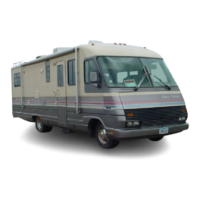.
SWING
DOWN
DINETTE TABLE
WARNING
OUTSIDE
STORAGE
COMPARTMENT
ARE
NOT
SEALED,
VENTED
ENCLOSURES, AND MAY
BE
ACCESSIBLE FROM INSIDE THE
MOTOR HOME.
USECAREWHEN
STORING
FLAMMABLE,
VOLATILE
LIQUIDS, HAZARDOUS CHEMICALS
CR
EQUIP"v1ENT
IN
THESE
AREAS.
STORAGE
Storage
facilities
in
your
motor
home
have been especially
designed to remain secure while
the
vehicle
is
in
motion.
Exterior
compartments
have
key-operated
locks.
The
LP
gas
compartment,
is
required by fire
prevention
regulations
to
be
unlocked
at
all
times.
Drawersrest
in
small
notches
or
detents,
when closed;
to
open,
lift slightly
to
clear
the
detent,
then pull
open.
For
best results,
follow
a few
simple rules when
stowing
articles
in
the
motor
home.
1. Always keep
tools
and
equipment
stored
in
areas
where
they
will
not
shift
while traveling.
2.
Wherever possible, place heavy articles
in
storage
compartments
which are low
and
between
the
axles
for
better
weight
distribution.
11
3.
Use
a
"packing"
technique
of
the
articles
in
a
compartment
to
prevent shifting.
If
necessary,
secure
articles with
straps
to
prevent
movement.
4.
Be
sure
that
containers
holding
liquidS are
capped
and
cannot
tip
or
spill. When glass
containers
(or dishes)
are
transported,
secure
them
well
to
protect
against
accidental breakage.
5. Exterior
storage
compartments
may
not
be water-
tight in all
climate
conditions.
Any
articles
which
could be damaged by
water
shou
Id
be carried
inside
the
motor
home.
Free
Standi
ng
Fu
rn
itu re
When preparing
for
travel, be sure
to
secure
free-standing
furniture
against
motion.
Traveling
motions
can
cause
these
items
to
move
around
inside
the
motor
home,
possibly
damaging
other
furniture,
cabinetry,
or
flooring.
Sudden
stops
could
cause moving
furniture
to
become
hazardous.
CONTROLLING MOISTURE
CONDENSATION
Just
as moisture collects on
the
outside
of
a glass
of
cold
water
during humid
weather,
moisture
can
condense
on
the
inside surfaces
of
your
recreational vehicle during use
in
cold
weather
when
humidity
of
the
interior
air
is
high.
This
condition
is
much
greater in a recreational vehicle
than
in
most
houses because
the
insulated walls
of
the
vehicle are much
thinner
than
house walls,
and
the
small
size
and
tight
construction
of
the
vehicle allow a quick
buildup
of
high
moisture
levels in
the
inside air.
The
air inside a recreational vehicle
can
contain
a sur-
prisingly large
amount
of
water
vapor.
Estimates
indicate
that
a family
of
four
can
vaporize
up
to
three
gallons
of
water
daily
through
breathing,
cooking,
bathing,
and
washing
washing.
Unless
this
water
vapor
is
carried
outside
by
ventilation,
or
condensed
by a
dehumidifier,
it will con-
dense
on
the
inside
of
windows
and
walls.
You
can
reduce
or
eliminate
interior
moisture
conden-
sation during cold
weather
by
taking
the
following
steps:
1. Ventilate with
outside
air.
Partially
open
one
or
more
roof
vents
and
one
or
more windows
to
provide
controlled
circulation
of
outside air into
the
interior. While
this
ventilation
will increase
furnace
heating load, it will greatly
reduce,
or
eliminate,
water
condensation.

